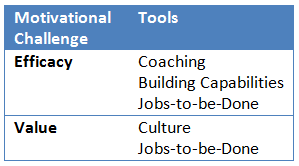This is the second part of a two-part blog. For part one, please click here.
As noted in part one of this blog, efficacy and value are two critical components of motivation.
Culture
If you are going to try to address the value side of motivation by changing what students naturally prioritize, your best tool for doing so is culture. Many of the leading success stories in education reform—such as that of the KIPP schools—highlight the power and importance of a strong school culture.
Culture develops naturally as a group of people work through shared challenges. The processes and priorities that emerge for dealing with those challenges become the group’s culture. Strong, positive culture is built when shared beliefs develop about the processes and priorities that produce success. A key thing to understand about building a positive culture, however, is that it has to be built on realized success. Merely preaching to students that certain processes and priorities are good for them is not enough. Anecdotal success stories about real people and the examples of peers and adult role models are often more compelling tools for influencing students’ values and priorities. Ultimately, however, students must see from their own experiences that the processes and priorities we want them to adopt actually produce results that they want for themselves.
One advantage that teachers and administrators have is that they can strongly influence what success looks like in their schools and classrooms. They have the ability to control rewards and punishments, using tools such as assessments, public praise, classroom celebrations, time outs, lunch detentions, and so forth. Once it is established, a strong culture is also self-reinforcing. Culture can give personal values social value by attaching social acceptance and recognition to those values.
Our ability to influence values through culture, however, has its limitations. Adults must recognize that they cannot control all avenues that students look to for success. Unfortunately, students who consistently fail at adult-sanctioned goals and activities often look to fulfill their need for success through other avenues, such as by acting out as a class clown or a school bully. This is why giving all students the capabilities they need to succeed is an important part of building strong culture. Students also come to school with processes and priorities that are instilled by the cultures of their families and their communities. Sometimes these external cultures align with school culture. In other cases, they work against student achievement. Culture is often difficult to instill because students have so many experiences outside of school that can either support or subvert the values you want them to adopt.
Jobs to be Done
Although culture is extremely important, it is not the only tool for addressing the value side of motivation. Rather than trying to change what students value, educators can reframe the problem and instead consider how to align their teaching strategies with what students already value. This strategy is embodied in a framework known as Jobs to be Done.
The Jobs-to-be-Done framework originated as a theory for understanding how best to market products. According to this theory, the jobs that people are trying to fulfill in their lives are what motivate their purchases. In application, this theory tells companies that rather than thinking about how to get their products into the right channels to target the right demographics, they need to think about how to best integrate the entire value chain to meet customers’ unfulfilled jobs. Put succinctly, “the customer doesn’t want a quarter-inch drill. He wants a quarter-inch hole.”
This framework can also be applied to help educators think about what students “hire” school to do. Unfortunately, education is not a “job” that most students are trying to do. As parents and educators, we want students to go to school because we understand that it will have a major impact on their adult lives. Nevertheless, the job of “make me a successful adult” is so far off that students just don’t factor it into their daily thinking. This lack of long-term foresight is not a problem exclusive to children. How many right-minded adults would regularly hire products or services that don’t provide benefits until 13-20 years after the time of purchase? Savings and retirement accounts are examples of these types of products, and economic data show that on average adults do not make these products a priority.
In order to motivate students to make the long-term investment in education, the experience of education needs to pay short-term dividends along the way by fulfilling the jobs that students naturally prioritize. Our application of the Jobs-to-be-Done theory suggests that students have two basic jobs they might hire schooling to fulfill: 1) “help me feel successful,” and 2) “help me have fun with my friends.” Although much of what students value is unique to their personalities and interests, these two jobs embody innate values that are intrinsic to human nature. The Jobs-to-be-Done framework helps us think through how to align education with what students value, and then how to integrate educational experiences in ways that address students’ capabilities and their sense of efficacy. Our white paper, “Rethinking Student Motivation” further explains how to this theory can help educators develop motivating instructional strategies for their students.
Conclusion
Figuring out how to motivate students can be hard. Fortunately, good theory can make it easier. When using this theory of motivation, it is important to keep in mind that students need both value and efficacy in order to be motivated. Each alone is a necessary, but not sufficient, precursor to motivational success.



